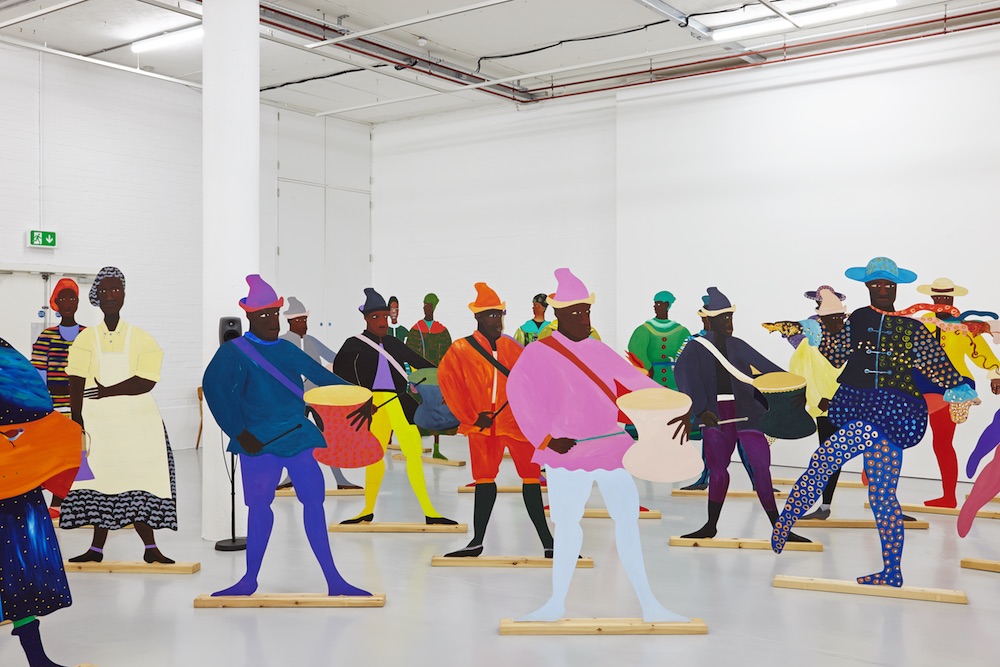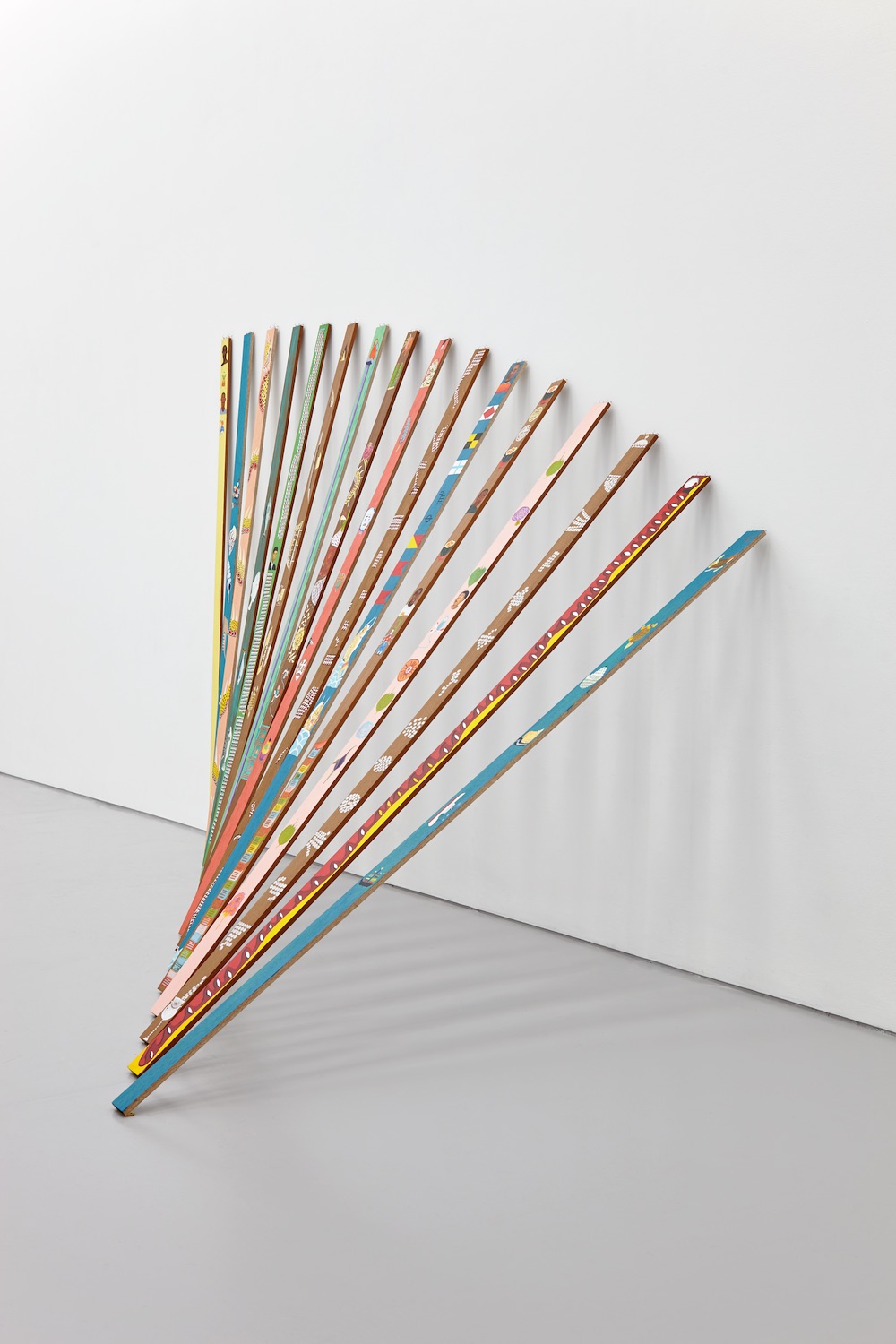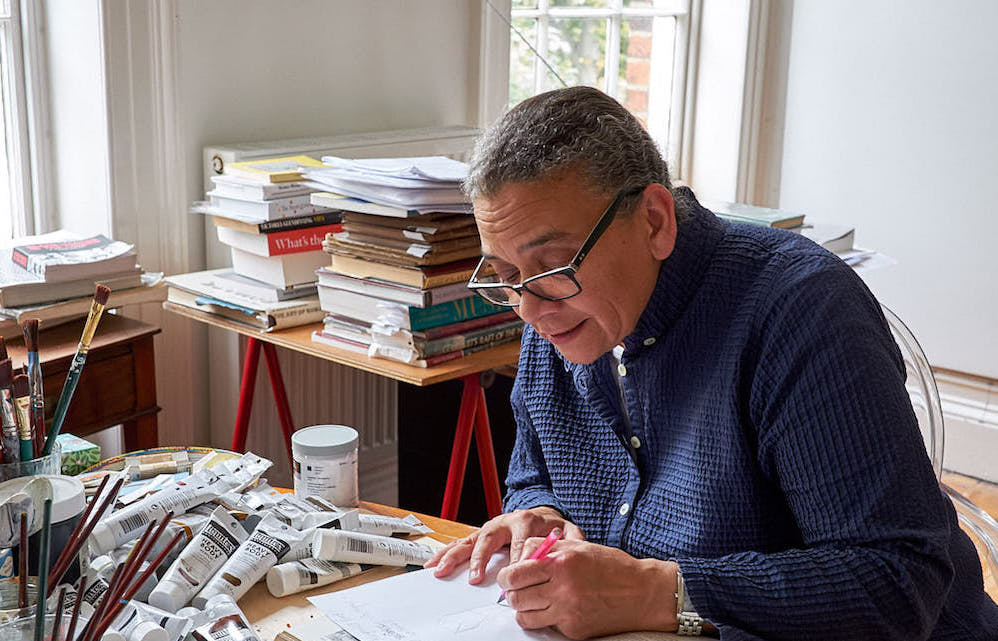
Since being nominated for the Turner Prize, the artist, curator and writer Lubaina Himid has been shocked by the number of strangers who have come up to her to offer congratulations in Preston, the post-industrial city in the north of England where she lives. “[The Turner Prize] has this huge, huge impact that I never, ever understood until now. I feel like I need a blonde wig and sunglasses because everybody knows who I am,” she laughs.
The recent scrapping of the Turner’s age limit of fifty has given it a much-needed injection of life by opening up the field to overlooked older artists such as Himid, now sixty-two. Another welcome aspect of this year’s prize, especially in light of Brexit with its nationalistic overtones, is the diversity of the shortlisted candidates. Himid was born in Zanzibar, Hurvin Anderson is of Jamaican heritage, Rosalind Nashashibi is Palestinian-British and Andrea Buettner is German.
Himid, known primarily for her vibrant paintings and cutout figures, was nominated for her trio of exhibitions earlier this year: two outstanding solo shows, Navigation Charts at Spike Island and Invisible Strategies at Modern Art Oxford, and a superb group show, The Place Is Here at Nottingham Contemporary, showcasing the work of black British artists from the 1980s.
- Portraits by Denise Swanson for Elephant
Artists such as Himid, John Akomfrah, Keith Piper and Sonia Boyce, who have spent decades fighting the invisibilizing forces of institutionalized racism and grappling with the colonial legacy, have seen a surge of interest in their work in the past couple of years. “It’s totally and utterly about a new set of curators aged between about thirty-five and forty-five who are wondering why on earth they didn’t know about us sooner, why the slightly older generation of curators hadn’t quite embraced what we were doing,” explains Himid, who is professor of contemporary art at the University of Central Lancashire and leads the Making Histories Visible research project.
The British art establishment’s exclusion of black diaspora artists wasn’t down to ignorance, argues the eminent art historian Griselda Pollock, professor of social and critical histories of art at Leeds University. “It’s not just benign neglect, it’s a continuous closing of the doors. It’s not that they didn’t know, it’s much more active.” The reason these works didn’t find favour for so long, Pollock suggests, was that “it requires you to recognize that here is a world of experience which is a world of beauty, imagination, pain and painful history that isn’t about the white person. They don’t recognize themselves in it and then they say ‘well I don’t know if this is ok’.” Pollock has followed Himid’s work since the 1980s and sought to instate it in the canon through her writing: for example, putting her in conversation with the Italian Baroque painter Artemisia Gentileschi in her 1999 book Differencing the Canon: Feminist Desire and the Writing of Art’s Histories.
“The black body is rarely represented within the gallery space”
Not only was Himid a pivotal presence in the black British arts movement, she has tirelessly promoted her black female peers such as Claudette Johnson, Maud Sulter and Ingrid Pollard, who have struggled against the double whammy of racism and sexism, their stories conspicuously absent from most art-historical narratives. She curated Five Black Women at the Africa Centre in 1983, Black Women Time Now at Battersea Arts Centre in 1983–84 and The Thin Black Line at the Institute for Contemporary Art in 1985.
Black women occupy a prominent position in Himid’s work. On entering the show at Modern Art Oxford, for instance, one was confronted by a fabric painting of two monumental black women bounding with ecstatic abandon across the sand in a direct appropriation of Picasso’s famous 1922 work Two Women Running on the Beach. Himid’s women wear dresses collaged with airmail envelopes and are symbolically pulled forwards out of the confines of their modernist painting by four fierce cutout dogs to the right, kicking up sand as they go at two cutouts of white men’s heads to the left. “At the time all of us were talking about how Picasso had been so inspired by the exhibitions he’d seen of African art and taken freely, as artists do, from those masks and statues and I felt equally able to take something back. I didn’t feel any guilt,” she says.

Himid trained in theatre design at Wimbledon College of Art in the mid-seventies, which clearly fed into her set-like installations using painted cutout figures. At Spike Island visitors had the rare chance to see in its entirety her spectacular 2004 work Naming the Money, composed of a hundred wooden lifesize cutouts of slaves dressed in finery, who had been forcibly uprooted from their homes to serve in European courts.
This crowd made up of drummers, dog tamers, ceramicists and mapmakers highlights the enormous contribution that slaves and servants made to Europe’s economy and culture. On the reverse the figures bear a short text that dignifies each one by naming them and telling their individual stories. These poignant accounts, which are woven into an accompanying soundtrack, speak of longing, homesickness, displacement, but also of extraordinary resilience: “My name is Akin. They call me Jack. I used to measure mountains. Now I measure the estate. But I have the sky.”
“That’s very much what the work’s about. Look at it, have a conversation and then go do something”
This work had a massive impact on visitors, especially among the black community in Bristol and beyond, says Spike Island director Helen Legg. “A lot of people were commenting on how it made them feel to walk into a gallery and see a hundred black faces looking back at them. The black body is rarely represented within the gallery space.”
The original idea of using cutouts, Himid says, came from “that funny little waiter” one saw outside cafés holding a menu, as well as cutout representations of various dukes that she saw on family visits to stately homes. Cutouts appealed because, unlike paintings, they could be moved around and given new meanings by the viewer. Being lifesize, they also seem to demand a reaction. “That’s very much what the work’s about too,” she agrees. “Look at it, have a conversation and then go do something.”

Conversations are crucial to Himid’s oeuvre. There are the conversations between the viewer and her art, between the protagonists in her work and even invisible conversations across continents through the language of pattern in her semi-abstract pieces. I’m thinking here of her work Cotton.com (2002), made up of a hundred black-and-white oil-on-canvas panels, which imagines a non-verbal dialogue between cotton plantation slaves during the American Civil War and Manchester cotton-mill workers. The piece was inspired by a historic and little-known show of solidarity by these English mill workers, who in 1862 pledged to support Abraham Lincoln’s naval blockade of slave-picked cotton, despite incurring severe hardship as supplies ceased.
Himid left Zanzibar when she was just four months old after her father died of malaria. She was brought up in North London by her mother, a textile designer, which partly accounts for her fascination with textile and pattern. Bridget Riley’s paintings were an early influence and taught her about using dazzling colours to lure the viewer.
“Going through my mind all the time are those journeys that Africans made in the hold of ships, that horrific introduction to this monster called the sea”
More recently she has taken inspiration from the exuberant patterns of African fabrics such as the kangas widely used in East Africa, which she has incorporated into large paper works. Himid has only gone back to Zanzibar once—in 1997—long deterred by the associated trauma and fear that she wouldn’t belong there. Her visit spawned her Zanzibar series of abstract paintings featuring multifaceted geometrical shapes that sparkle and refract light like dancing sunrays on waves, encompassing the myriad emotions evoked by her birthplace.
The sea threads through her work as a recurring, ambivalent motif. It reflects her island heritage; it represents an intriguing painting problem; most of all, it is, for Himid, a boundless source of danger. “Going through my mind all the time are those journeys that Africans made in the hold of ships, that horrific introduction to this monster called the sea.”

Drowned Orchard: Secret Boatyard, 2014. Installation view: Navigation Charts, Spike Island, Bristol. January–March 2017
The way ordinary lives are wrenched and buffeted by the global forces of trade and politics, greed and power, is a long-standing preoccupation of Himid’s. Her disquieting recent series of paintings Le Rodeur portrays groups of black people staring blankly into the distance, the sea a menacing presence beyond. The three paintings take their title from a French nineteenth-century slave ship, from which thirty-six slaves were cast overboard when they contracted a disease that made them blind, rendering them unsellable. The case was only logged for insurance purposes for the financial loss of the human “cargo”.
Himid doesn’t seek to capture the horror of this event naturalistically. Each painting features strips of abstract geometric pattern, which she suggests might symbolize the unpaintable. A new surreal element has crept into these works, such as a woman with the head of a bird. Himid isn’t sure where it came from—though she admits to being a “secret admirer” of the British surrealist painter Leonora Carrington—and doesn’t want to resolve any mysteries. “I’m sort of letting the paintings do the work, which I’m not sure that I always used to do,” she says.
Given the present fractious political climate, particularly in Britain, this year’s Turner Prize has a significance beyond the art world. “It’s about who are we as a country, how inclusive are we, all of those questions that have been thrown up by this Brexit mess,” says Spike Island’s Legg. Himid has undeniably breached the British art citadel and doggedly achieved much for herself and her peers. That said, we await a major London retrospective of her work. And much remains to be done to combat racism and sexism in art institutions, education and society. Is she optimistic that art can effect change? Without missing a beat, Himid answers, “Oh absolutely, absolutely. I don’t think I could keep doing it otherwise.”
This feature originally appeared in issue 33
BUY ISSUE 33







